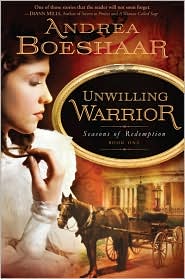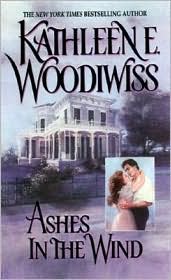By Andrea Boeshaar
Research for a historical fiction novel has to move beyond watching Little House on the Prairie reruns. For instance, men in the late 1800s didn’t necessarily wear 1970-style haircuts. While the movie Sarah, Plain and Tall may be historically accurate on many levels, authors need to remember that women in the 19th Century didn’t have eyeliner and lipstick. They were, in fact, more “plain” than the way actress Glenn Close appeared in the flick.
In researching the antebellum period for my latest novel Unwilling Warrior, I read A Diary of Dixie by Mary Chestnut and Sarah Morgan’s The Civil War Diary of a Southern Woman. I also studied books about photography process and purchased Mathew Brady’s Civil War, a collection of photographs from the Civil War. I also watched Ken Burns’ documentary about the American Civil War (PBS Home Video). Many of Mathew Brady’s photographs appear in the film. I also perused Shelby Foote’s expert texts on the Civil War and Michael J. Varhola’s Everyday Life During the Civil War (Writers Digest).
In addition, I used the Internet in my research. This can be unreliable because anyone can put anything up on a website. Bestselling author Tracie Peterson once told me a good rule of thumb is to find three different sources on a particular topic. If your references say the same thing, the info is likely reliable.
For instance, I found a site that had good information about fashion during the Civil War. I scoured the site and then read Godey’s Ladies Book, which is in my personal library, but found, to some degree, online as well, and I discovered the two sources said largely the same thing, except that Fanny & Vera’s site had more details about creating Civil War/Victorian costumes for reenactments and such. Then I found a third site, Garments by Glenda where one can actually purchase outfits for reenactments. It’s not just a sew-it-yourself kind of site. To me, as a historical fiction author, learning details surrounding fashion of the time period in which I’m writing allows me to add realistic description. Thus, I’ve found these two sites along with Godey’s to be valuable resources.
Besides the Internet and my ever-growing personal history book collection, I found the public library to still be a treasure trove of great information. Many references via the public library can be accessed online with a valid library card.
Why historical fiction?
For me, I’ve been enthralled with history ever since I was a girl in junior high. As a family we toured the battlefields of Gettysburg and Vicksburg University of Wisconsin Milwaukee , Wisconsin
When I was in junior high school my family and I visited friends in the New Orleans
Which brings me to my next point. No reference book can replace personal experience. As historical authors we, of course, cannot go back in time – even if our characters do. But visiting restored plantations and viewing reenactments can be very inspiring – almost like you’re really there. If your chosen time period is World War II, for example, it might also behoove you to interview surviving veterans. Same with the Vietnam
But as historical novelists, we’re not after textbook drama. We want to impart that willing suspension of disbelief to our readers. That involves imagination.
And here’s where Hollywood
And then, as a young mother, I read Kathleen E. Woodiwiss’s Ashes in the Wind. The novel is one of my favorite stories of all time. I fell in love with the handsome Yankee Army surgeon and sympathized with the deceitful Southern girl on a mission who blossomed into a beautiful woman. I knew I wanted to write a story just as powerful and beloved.
And yet, one that was very different.
In 1991, I gave my heart to Jesus Christ. Soon after, I realized I was call to write Christian romance. My world changed. My writing changed. But my desire to write a romance set during the Civil War remained.
In 1994 my first novel was published. A grand attempt. But due to word length constraints, the story was only a shadow of what I really had wanted to create.
Sixteen years later, I was given my chance to write the story that’s lurked in my heart for nearly four decades. The first novel in my Seasons of Redemption series, Unwilling Warrior, is the result.
Worlds collide in my book – the North and the South, of course, but also city life verses prairie life – as well as good verses evil.
 Unwilling Warrior is wrought from a childhood fantasy and encouraged by the classics and years of research. It captures the easy dignity of the antebellum era, the mayhem of the Civil War, and the simplicity of the prairie. But more, it’s an enduring love story of two people caught up somewhere in the middle.
Unwilling Warrior is wrought from a childhood fantasy and encouraged by the classics and years of research. It captures the easy dignity of the antebellum era, the mayhem of the Civil War, and the simplicity of the prairie. But more, it’s an enduring love story of two people caught up somewhere in the middle. So what about your historical novel? Are you feeding your imagination by watching movies, television shows, and reading stories set in the time period in which you’re interested? If you are, that’s good – but it’s not good enough.
Novelists must dig for those details that can lend reality to their stories. Doing so will captivate readers and leave everlasting impressions. It’s what bestselling fiction is all about.

14 comments:
Good advice, Andrea. Thanks for the reminder!
cb
http://sunnebnkwrtr.blogspot.com/
Leave a comment and you'll be entered into the drawing to win an autographed copy of "Unwilling Warrior"!!
I would love to win a copy of this book. Thank You for the chance.Angela from Kentucky
I'd love to wind a copy. Thanks for the grest post.
You don't have to enter me in the drawing, as I already have a copy of Unwilling Warrior. I LOVED this book! Andrea is a fabulous writer and knows who to bring a historical novel to life. I enjoyed reading about your research and your passion for the Civil War era.
Miralee Ferrell
Ah, historical research. Nice post, Andrea. I could remain happily immersed in it but then I'd never get my books written.:) So your daddy was a social worker? Me too, and my hubby.
I wish I could go to England every once and awhile to research but that is not financially feasible. However, I was there many years ago, so I'm not totally without some experience of the country first hand. However, the Regency era in which I write was much different from todays England.
Loved Ashes in the Wind and I loved Gettysburg too. I grew up in Western Pennsylvania so I haven't been more than a couple of times.
Thank you, Miralee. You've been a huge support to me since I've begun writing for Charisma House/Realms and I'm so appreciative!!
Jilly, we have more in common than we know. :)
Andrea, I appreciated how you wove the threads of your research into the story to make it realistic. Mahvalous job.
Very interesting article!! I'm wrote an historical novel that was basically my life - only 60 years earlier. Personal experience was very important, but I had to do the research to fit in the 1920's era. It was a learning experience! Connie from Wisconsin
Now we know one secret of your magnificent novels is diligent research!
What a fascinating post.
My mother introduced me to novels by Kathleen Woodiwiss years ago. "Ashes in the Wind" is one of my favorites too. I love Historical Christian Fiction. They are so awesome to read especially on a cold evening by the fireplace.
Thank You for sharing your post.
I enjoyed it immensely.
God Bless,
Niecy
Very good advice. For my WWII novel set in the Netherlands, I was able to interview three men who lived there at that time. It was one of the best days of my life - history come alive. Research is one of the best things about writing!
www.liztolsma.blogspot.com
Great post, Andrea. I love research and want to get it right. I love history and have enjoyed researching my family's pasat. I have letters written by my great-grandfather to my great-grandfather before they were married and he was in the Civil War. I also have a letter her father wrote to her when she went off to school in New Orleans in 1859. Things like that whet the appetite to tell their stories. Looking forward to reading your book.
Post a Comment